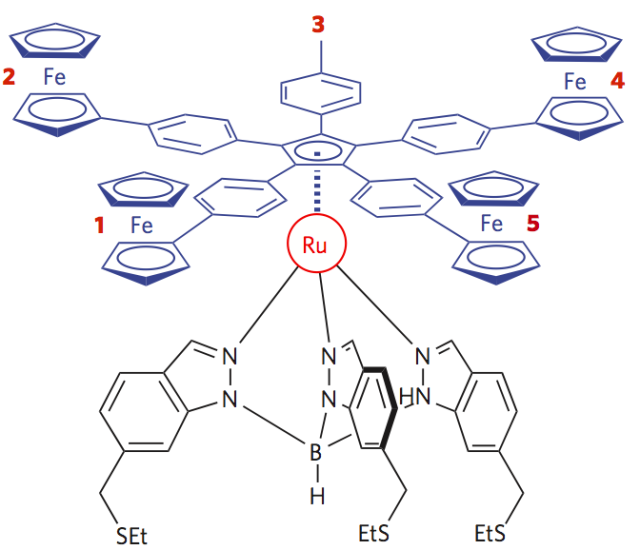 |
| Perera et. al., Nature Nanotechnology |
Writes John Timmer for Ars Technica:
The base of the system involves a boron atom that coordinates three ringed structures that are chemically similar to the bases of DNA. Nitrogens at a corner of these ringed structures coordinate the ruthenium atom, placing it at the peak of a three-sided pyramid. (This compound has the succinct name [n5-1-(4- tolyl )-2,3,4,5-tetra(4-ferrocenylphenyl) cyclopentadienyl hydrotris [6-((ethylsulphanyl)methyl)indazol-1-yl] borate ruthenium(II)], which should provide some sense of its complexity.)
The authors cleaned off a gold surface, and then dropped the pyramids onto it. With those in place, they layered on something that looks a bit like a five-armed windmill. A five-atom ring sits at the center, with further rings extending out at each corner to form the blades of the windmill. For four of the five arms, the authors placed a complex of rings surrounding an iron atom. The fifth arm was left blank so that they could actually tell when something shifted. (If all arms were identical, it would be impossible to tell different configurations apart.)
It was possible to arrange this molecule so that the central five-carbon ring sat directly on top of the ruthenium atom. That let the ruthenium act like a ball bearing, allowing the molecule sitting atop it to rotate, spinning like a windmill tilted on to its back, with its blades oriented horizontally.
To actually get it to rotate, a scanning-tunneling microscope was again used to inject electrons into the system. The added charges allowed the rings to overcome interactions with the base, and click one position forward (with five positions, corresponding to the five arms, providing a complete rotation). But the authors could also control the direction of rotation. Pump the electrons into one of the iron-containing arms, and the motor would turn in one direction; put them into the single truncated arm, and it would turn in the opposite one.These little things take a lot to power, though. It takes a scanning-electron microscope to accurately inject the electrons into the system; without them, these systems aren't going to find practical use, but it's a remarkable demonstration of molecular engineering, and adds to our knowledge of what kinds of molecular mechanics are even possible.
The study was published on 23 December 2012 and was conducted by U. G. E. Perera, H. Kersell, Y. Zhang & S-W. Hla (the Nanoscale and Quantum Phenomena Institute, Ohio University, Athens, Ohio), G. Vives, J. Echeverria, M. Grisolia, C. Joachim (GNS & MANA Satellite, CEMES, CNRS, Toulouse Cedex, France), G. Rapenne (Université de Toulouse, Toulouse, France), F. Ample and C. Joachim (IMRE, A*STAR [Agency for Science, Technology and Research]), 3 Research Link, Singapore).




